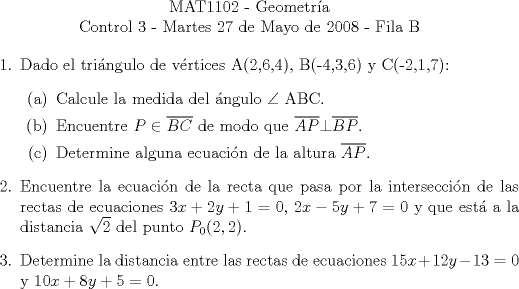|
|
|
|
|
|
|
  |
 May 31 2008, 12:30 AM May 31 2008, 12:30 AM
Publicado:
#1
|
|
 Dios Matemático Supremo Grupo: Usuario FMAT Mensajes: 3.812 Registrado: 4-November 07 Desde: Santiago Miembro Nº: 12.213 Nacionalidad:  Colegio/Liceo:  Universidad:  Sexo:  |

-------------------- |
|
|
|
 May 31 2008, 07:23 PM May 31 2008, 07:23 PM
Publicado:
#2
|
|
 Staff FMAT Grupo: Moderador Mensajes: 2.604 Registrado: 2-March 07 Desde: Somewhere over the rainbow Miembro Nº: 4.244 Nacionalidad:  Colegio/Liceo:  Universidad:  Sexo:  |
-------------------- INRIA - Francia, Sophia Antipolis Biocore Team Ingeniero Civil en Biotecnología Ingeniería Civil Químico  “(…) los elementos que él (¿o Él?) [Dios] mismo nos ha dado (raciocinio, sensibilidad, intuición) no son en absoluto suficientes como para garantizarnos ni su existencia ni su no existencia. Gracias a una corazonada puedo creer en Dios y acertar o no creer en Dios y también acertar" Mario Benedetti ![TEX: \[\iiint\limits_\Omega {\left( {\nabla \cdot \vec F} \right)dV} = \iint\limits_{\partial \Omega } {\left( {\vec F \cdot \hat n} \right)}dS\]<br />](/tex-image/662cf378c88b8d7170f7919ce7dc427a.png) |
|
|
|
 May 31 2008, 08:02 PM May 31 2008, 08:02 PM
Publicado:
#3
|
|
 Dios Matemático Supremo Grupo: Usuario FMAT Mensajes: 1.818 Registrado: 21-December 06 Miembro Nº: 3.434 |
Hahaha si...
Tenias que hacer un haz de rectas y dp con la formula de la distancia te queda una ecuacion directa para encontrar la incognita del haz de rectas. -------------------- |
|
|
|
  |
1 usuario(s) está(n) leyendo esta discusión (1 invitado(s) y 0 usuario(s) anónimo(s))
0 miembro(s):
| Versión Lo-Fi | Fecha y Hora actual: 10th April 2025 - 11:51 AM |






![TEX: \[\mathfrak{L}=\int_{-\infty}^\infty e^{-289x^2}dx=\frac{\Gamma (\frac{1}{2})}{17}=\frac{\sqrt{\pi}}{17}\]](./tex/e0e88dba678ca3ead120b088f41191b2.png)





![TEX: \[<br />\begin{gathered}<br /> \boxed{B2} \hfill \\<br /> {\text{Para encontrar el punto de interseccion:}} \hfill \\<br /> \left. {\underline {\, <br /> \begin{gathered}<br /> 3x + 2y + 1 = 0 \hfill \\<br /> 2x - 5y + 7 = 0 \hfill \\ <br />\end{gathered} \,}}\! \right| \hfill \\<br /> \Rightarrow x = - 1 \wedge y = 1 \hfill \\<br /> {\text{Entonces el punto A}}\left( {{\text{ - 1}}{\text{,1}}} \right){\text{ pertenece a la recta que buscamos}}{\text{, Deigamos que el}} \hfill \\<br /> {\text{punto B}}\left( {x,y} \right){\text{ tambien pertenece a la recta y se sabe que P}}\left( {{\text{2}}{\text{,2}}} \right){\text{ es perpendicular}} \hfill \\<br /> {\text{a ella en el punto B}}{\text{. Quedando algo asi:}} \hfill \\ <br />\end{gathered} <br />\]<br />](./tex/8354384945fb05f676874508637a2b3c.png)

![TEX: \[<br />\begin{gathered}<br /> \overline {{\text{AP}}} = \sqrt {\left( {x + 1} \right)^2 + \left( {y - 1} \right)^2 } \hfill \\<br /> \overline {{\text{AP}}} = 2\sqrt 2 \hfill \\<br /> \hfill \\<br /> {\text{Por pitagoras se obtiene }}\overline {{\text{AB}}} = 2\sqrt 2 {\text{ con lo que podemos formar el siguiente sistema}} \hfill \\<br /> {\text{de ecuaciones:}} \hfill \\<br /> \hfill \\<br /> \left. {\underline {\, <br /> \begin{gathered}<br /> {\text{2}}\sqrt {\text{2}} = \sqrt {\left( {x + 1} \right)^2 + \left( {y - 1} \right)^2 } \hfill \\<br /> \sqrt 2 = \sqrt {\left( {x - 2} \right)^2 + \left( {y - 2} \right)^2 } \hfill \\ <br />\end{gathered} \,}}\! \right| \Leftrightarrow \left. {\underline {\, <br /> \begin{gathered}<br /> 8 = x^2 + 2x + 1 + y^2 - 2y + 1 \hfill \\<br /> 2 = x^2 - 4x + 4 + y^2 - 4y + 4 \hfill \\ <br />\end{gathered} \,}}\! \right| ( - ) \hfill \\<br /> \hfill \\<br /> {\text{Al efectuar la recta nos queda: }}y = - 3x + 6,{\text{ la cual al reemplazarla en la primera}} \hfill \\<br /> {\text{ecuacion al cuadrado nos queda:}} \hfill \\ <br />\end{gathered} <br />\]<br />](./tex/0161b61d2bde8c64cff40aa5d09b6989.png)
![TEX: \[<br />\begin{gathered}<br /> x^2 + 2x + \left( {6 - 3x} \right)^2 - 2\left( {6 - 3x} \right) - 6 = 0 \hfill \\<br /> 5x^2 - 14x + 9 = 0 \hfill \\<br /> x = \frac{{14 \pm \sqrt {196 - 180} }}<br />{{10}} \hfill \\<br /> x = \frac{{14 \pm 4}}<br />{{10}} \hfill \\<br /> x_1 = \frac{{14}}<br />{5} \wedge x_2 = 1 \hfill \\<br /> \hfill \\<br /> {\text{Reemplazando en }}y = - 3x + 6 \hfill \\<br /> y_1 = \frac{{ - 8}}<br />{5} \wedge y_2 = 3 \hfill \\<br /> \hfill \\<br /> {\text{Por lo que se tienen dos alternativas de las coordenadas de B}} \hfill \\<br /> B_1 \left( {\frac{{14}}<br />{5},\frac{{ - 8}}<br />{5}} \right) \wedge B_2 = \left( {1,3} \right) \hfill \\ <br />\end{gathered} <br />\]<br />](./tex/8bed866ee978362c42433bca1b9753e7.png)
![TEX: \[<br />\begin{gathered}<br /> {\text{El problema por lo tanto ahora es discrminar cuales son las coordenadas que nos}} \hfill \\<br /> {\text{sirven}}{\text{, para ello sigamos diciendo que B es de la forma }}\left( {x,y} \right){\text{ para generalizar}} \hfill \\<br /> {\text{lo siguiente: }} \hfill \\<br /> \hfill \\<br /> m_{AP} = \frac{{y - 2}}<br />{{x - 2}} \wedge m_{AB} = \frac{{y - 1}}<br />{{x + 1}} \hfill \\<br /> \hfill \\<br /> {\text{Como las dos rectas son perpediculares}}{\text{, entonces se cumple: }} \hfill \\<br /> m_{AP} \cdot m_{AB} = - 1 \Leftrightarrow \frac{{y - 2}}<br />{{x - 2}} \cdot \frac{{y - 1}}<br />{{x + 1}} = - 1 \hfill \\<br /> {\text{Para ver que coordenas de B nos sirve solo reemplazaremos}} \hfill \\<br /> \hfill \\<br /> B_1 :\frac{{\left( {\frac{{ - 8}}<br />{5} - 2} \right)\left( {\frac{{ - 8}}<br />{5} - 1} \right)}}<br />{{\left( {\frac{{14}}<br />{5} - 2} \right)\left( {\frac{{14}}<br />{5} + 1} \right)}} \ne - 1 \hfill \\<br /> \hfill \\<br /> B_2 :\frac{{\left( {3 - 2} \right)\left( {3 - 1} \right)}}<br />{{\left( {1 - 2} \right)\left( {1 + 1} \right)}} = - 1 \hfill \\<br /> \hfill \\<br /> \Rightarrow B\left( {1,3} \right){\text{ y como se sabe que A}}\left( {{\text{ - 1}}{\text{,1}}} \right){\text{ solo queda calcular la ecuacion de la recta}} \hfill \\<br /> {\text{llego ado a:}} \hfill \\<br /> \hfill \\<br /> \boxed{y = x + 2} \hfill \\<br /> \hfill \\<br /> \hfill \\<br /> \hfill \\<br /> \hfill \\<br /> \hfill \\ <br />\end{gathered} <br />\]<br />](./tex/1bfe1bb09ab5b16b7309bf9103000411.png)
